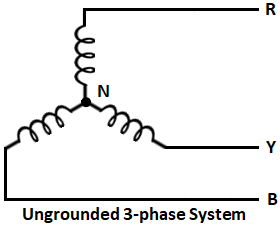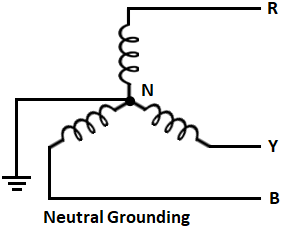The neutral grounding is nothing but connecting the neutral point of the supply system or rotating machine or transformer to the earth directly or through some circuit elements. A three-phase system can be operated in two ways, they are ungrounded or isolated neutral system and grounded or earthed neutral system (i.e., neutral grounding).
Ungrounded or Isolated Neutral System :
In this system, there is no connection between the neutral point of the system and the earth i.e., the neutral is isolated from the earth as shown below. In reality, there exists a capacitive coupling between conductors and between each conductor and the earth.
However, there are technical and operational issues associated with this system. The following are the disadvantages of an ungrounded neutral system,- Under a single line to ground fault, the voltage to earth of healthy phases becomes full line value. This may result in insulation breakdown and may even lead to heavy phase-phase fault conditions.
- Trouble due to arcing grounds is present.
- The voltage surge due to lightning strike cannot find a path to earth to discharge, thereby it causes damage to the equipment in the power system.
- It is difficult to detect earth faults in the ungrounded neutral systems. Thus the earth fault relaying becomes complicated.
Due to the above disadvantages, ungrounded systems are not commonly used and these problems can be overcome by a grounded neutral system.
Neutral Grounding or Grounded Neutral System :
Need for Neutral Grounding :
At present, there is a trend towards effectively earthed systems because, in the case of large cities and industrial areas, the continuity of supply is so important that multiple lines or two-directional feeds are a must. The momentary line trip out on such systems will not affect the continuity of supply because additional circuits are available.
For this purpose, large equipment may be tied to these lines. Hence, the lightning arrestors costs and insulation costs of transformers and other equipment should be minimum.
This can be done only by effective grounding because when compared to other types of grounded systems, effectively earthed systems are less expensive for all operating voltages, as the voltage of healthy phases in case of line to ground fault does not exceed 80% of the line to line voltage, whereas in case of other groundings the voltage of healthy phases rises to about 100% of line to line voltage.
Hence, to ensure reliability and effective protection, the modern electrical circuits are effectively grounded. In a grounded neutral system or neutral grounding, the neutral of a system is connected to the earth or ground as shown in the below figure.
Advantages of Neutral Grounding :
The following are the advantages of neutral grounding,- The neutral point is effectively held at neutral i.e., the neutral point is stable under all conditions.
- Since the neutral point is not shifted, the voltage of healthy phases with respect to earth remains at normal value, unlike the ungrounded system where the voltages of healthy phases during an earth fault increase by √3 times their normal value.
- In a neutral grounded system, the voltage surges caused by arcing grounds are eliminated due to which the life of insulation in this system is long. Hence, the maintenance, repairs, and breakdowns are reduced. Also, the continuity of supply is improved.
- The overvoltages due to static induced charges and lightning surges are immediately discharged to earth without causing any disturbances.
- The earth fault current flowing through the neutral ground circuit is made almost equal and opposite to the line to earth capacitive currents of the healthy phases. Therefore, the arcing grounds are extinguished and the overvoltage surge due to arcing grounds is prevented.
- In neutral grounding, the earth fault current available is sufficient to operate the earth fault relay. This makes the operation of the earth fault relay simple in a neutral grounded system.
- Discriminative type protective gear can be installed in a neutral grounded system.
- The earth fault current can be controlled by employing resistance or reactance in the neutral ground circuit.
- Due to the limitation of arcing grounds, the service reliability is improved and unnecessary tripping of circuit breakers is also prevented.
- In neutral grounded systems, the safety of personnel and equipment is increased because of the operation of fuses or relays on ground faults and the limitation of voltages.
- Improved life of equipment, machines, and installation is achieved because of the limitation of voltage. Hence, the overall economy.
Types of Neutral Grounding :
Various methods of grounding the neutral of a system are,- Solid Grounding - In this method, the neutral is directly connected to the earth through a wire of negligible resistance and reactance.
- Resistance Grounding - In this method, a resistor is inserted between the path connecting the neutral to the earth to limit the earth fault current to a safer value.
- Arc Suppression Coil (Peterson coil) Grounding - This method uses an iron-cored reactor connected between the neutral point and the earth.
- Reactance Grounding - In this method, the neutral wire is connected to the earth through a reactance.
- Voltage Transformer Grounding - Here the primary winding of the voltage transformer is connected between the neutral and earth and the secondary is connected to a relay through a low resistor.
- Earthing Transformers (zig-zag transformer) - In this type, a three-phase, dry type, air-cooled auto-transformer with no secondary winding is used.
Neutral Grounding Practice :
There are several voltage levels between the generator voltage level and the distribution voltage level of the system. Each voltage level is provided with one neutral ground as shown in the below figure.
Grounding is also provided to each of the major bus sections in a power system. The grounding is not provided at the load end but is provided at the power source end.
In generator neutral grounding, the generator neutral is grounded depending upon the type of generator connection. If a number of generators are operating in parallel, then any one of the generators neutral is grounded. Whereas in the case of a unit system of generator connection, the generator neutral of each unit is grounded. In the case of main generator neutral grounding, the grounding is provided through a resistor, reactor, or voltage transformer.
For protection purposes in the grounding of the power transformer's neutral, the neutral point of the star side is generally grounded. Also, the star-connected side of the CTs and PTs are grounded so that a proper measurement of voltages, currents, kWh, and kVA can be done. It also ensures stability in the neutral.



